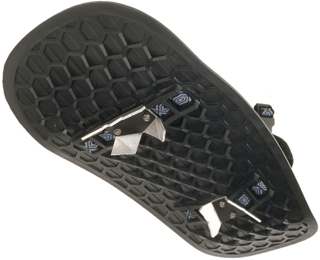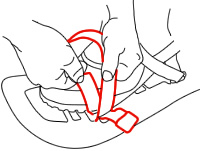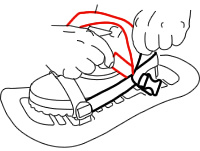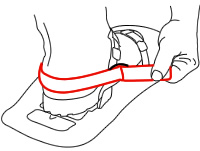
| Specs: | Medium | Large |
| Length | 18.1in | 20.1in |
| Width | 9.7in | 10.2in |
| Area | 146sq.in | 173sq.in |
| Weight | 2.60lbs/pr | 2.93lbs/pr |
| Load | 225lbs / 100kg | 280lbs / 125kg |
| Shoe Size | 6-11 US | 10-14 US |
Yowies come in two sizes: medium and large. The adjustable dual harness ensures that each size fits a range of boot sizes. There are two important factors to consider when determining the correct size Yowie: wearer height and stride, and wearer boot size. US-11 boot size is the stated maximum for the Medium Yowie, though depending on boot shape it may take up to size 12. US-6 boot size is the stated minimum for the Medium Yowie, though depending on boot shape it may take down to size Ladies 4. US-10 boot size is the typical minimum for the Large Yowie. It is important that the boot not be too small as the toe strap may slip forward over the boot toe. Height can be linked to boot size - smaller person, smaller foot - bigger person, bigger foot. In general, people taller than 5'11" prefer the Large Yowie. A person less than 5'10" may find the size of the Large Yowie platform awkward and difficult to use, and should not choose the Large Yowie for powder snow with a heavy pack. Yowies are a medium size snowshoe, not a powder snowshoe.
Yowies can be strapped to just about any boot. They are normally worn with hiking boots, cross-country ski boots (leather, plastic or composite), Sorels, snowboard boots or climbing boots (plastic, composite). It's really up to you - how far you are going and what other activities you are planning to undertake.
Lifetime Warranty on faulty materials or workmanship to original purchaser. Specifications may change without notice, with modifications to design or materials.
Deck platform. The deck material is injection moulded from a subzero engineering grade copolymer thermoplastic. This chemical combination of two plastics gives physical benefits and properties of each. Extremely lightweight, it is tougher and more durable than the base material of skis or snowboards. This semi flexible material has good elasticity, very good resilience and impact resistance. The polymer manufacturer has designed this copolymer specifically for extreme subzero use. It is UV stabilized and ISO9002 compliant. Yowies will bend, not break on the harshest surface.
The hexagon-patterned base provides excellent grip in all directions. On soft to firm snows, the hexagons work on a similar principle to the wax-less Fischer scale on cross-country skis. The hexagon pattern captures the snow, which can then be compressed in the shallow depth when the platform is stepped upon. Any side-slip has to shear the captured snow of the entire surface area of the deck. Similar to a snow ball, compacted snow is quite strong, and has a good shear strength. The extra aggressive raised hexagon pattern directly under the foot enables greater grip on firmer snows.
Crampons complement the hexagons by gripping snow or ice. The cleats are of high tensile marine grade aluminum with very open internal angles allowing ice to drop out. The black plastic inserts provide a non-stick surface along the bottom of the cleats. The 5083 high tensile marine grade aluminum is harder wearing and more difficult to bend than standard grades of aluminum, and also more corrosion resistant. All socket head bolts, washers and all-metal lock-nuts are 304 grade stainless steel, adjustable with a 2.5mm hex key. Wicking threadlocker applied to nuts, made ready for expedition use.
The unique Dual Harness Binding System securely and comfortably holds the boot. Inner straps prevent side movement of the boot on the deck. Outer straps prevent forward and backward movement, and stops the boot lifting away from the deck. This feature provides for an unparalleled stability for your boot on the flexible snowshoe. Quick and easy adjustment. An impact resistant nylon buckle-loop combination is used on the outer ankle, toe and heel straps. Secure, comfortable and easy to use, the ice/water repellent hook and loop fastener tape (Velcro) is used to hold the inner harness in place. Elastomer O-rings and end tips are used to stow excess webbing.
Ergonomic Design: Toe and heel of the deck are curved upwards to allow clearance with the snow while walking or running. The middle of the deck has two cambers, one longitudinally to pre-stress, making it more difficult to straighten (a similar principle to a ski camber). The other curve is across the shoe - it supplies extra movement as the shoe is flexed and relaxed. This movement helps clear away any ice buildup.
Tough, UV resistant woven Polyester Webbing. Available in Petrol (blue/grey) or Ochre (purple) pattern. Efficient Teflon® ice/water repellent is chemically bonded to the webbing.
High quality VELCRO™ fastener tape. An efficient Teflon® ice/water repellent is chemically bonded to the fastener tape. This uniquely maintains the tear-apart strength of wet hook and loop and is effective in preventing ice buildup.
Woven nylon hook and loop tapes. Designed for maximum cycling (opening and closing), the hook is made to maximize cycle life without reducing performance. Loop #2000 is used on all inner straps. This is an unnapped loop tape with a greater cycle life, less peel resistance and greater shear strength; typically used where closure is to be effected around a radius (such as a strapping application). Napped loop tape (randomly disoriented woven nylon loops) is used around the heel strap to stow excess webbing.
Durable Water Repellent (DWR), an efficient Teflon® ice/water repellent, is chemically bonded to both the webbing and Velcro. This helps to prevent ice buildup, and uniquely maintains the tear-apart and shear strength of wet hook and loop.
Impact-resistant nylon buckles excellently designed and engineered by Duraflex National Mouldings™ USA, made from impact-resistant super-tuff Dupont™ and Monsanto™ Nylons. Nylon is light, offers great impact resistance, and has a softer feel, and typically 20-30% higher tensile strength than the alternative.
Stealth Side Squeeze is a short sleek buckle that offers a hefty finger release area. The Virtual Locking® system has impressive strength, while the Duckbill Tensionlocks offer an enlarged finger release tab. An elegant shape dominates the simple functional appearance. Incorporates a patented high-release-angle feature. Loops are strong and durable, and most of all of proven reliability.
Stitching is heavy weight No 40 bonded nylon thread, manufactured by Venus of England. It is the toughest, most abrasion-resistant thread we can find. Load-carrying junctions are reinforced. Materials used will not deteriorate if stored while wet.
Fitting the Dual Harness System: Yowies should feel completely snug once fitted. The inner straps should not allow your boot to move sideways across the deck. Fit buckles to the outside of your body. Open and fully extend all straps, including inner & outer.
Balance deck Centre boot equidistant between matching numbers marked 1 2 3 on toe and heel of the deck. eg. toe on 2 heel on 2. Keep boot central to its sides.
 fig 1. Tension toe strap
fig 1. Tension toe strapStand on inner strap, pull its remaining end up and against your boot. Keeping tension on these two inner & outer straps, press hook and loop fasteners firmly together. Once inner straps are secure for both sides of toe, pull very outer strap through buckle by its Elastomer-end, tension until firm and comfortable. Excess strap can be stowed by passing it through the O-ring.
 fig 2: Tension ankle strap
fig 2: Tension ankle strap Similarly, standing on inner strap, pull to tension inner & outer straps, press hook and loop fasteners firmly together. Once inner straps are secure for both sides of ankle, close Side-Release-Buckle, pull very outer strap through buckle by Elastomer-end, tension until firm and comfortable. Excess strap can be stowed by passing it through the O-ring.
 fig 3: Tension heel strap
fig 3: Tension heel strapPull heel strap through buckle until firm and comfortable, applies correct tension to entire harness. Excess strap can be stowed by pressing hook and loop fasteners firmly together. If needed excess heel strap can be passed under Side-Release-Buckle.
Yowie agility - Comparison with Conventional Snowshoes.
Yowie has the advantage that it is elegantly simple, designed to have few parts that can break, wear, or be lost. Quick to put on, and easy to use. Unlike traditional free-heeling snowshoes, the Yowie platform is flexible with the heel secured to it. Benefits include: The sure-footed Yowie is a firm extension of your foot. You know exactly where the snowshoes are without having to look at them. Simply use normal techniques as you would when walking or running in boots alone. Yowies add that element of predictability: no more falling waist-deep in soft snow, and the cleats will not let you slip on ice.
Move backwards, sideways, turn around. A basic function that traditional snow shoes cannot do well. Yowies are easy to work in. Easily climb up or down the steepest soft snow. To ascend, kick-step as you would with boots alone. When descending, without a long free-heeling tail, you are able to kick-step down.
Yowies are fun as soon as you put them on, and you quickly become proficient. You can relax and enjoy your surroundings much more, since you do not have to watch your feet as you do with other snow shoes or skis.
The surface area of the platform is approximately four times larger than that of a boot. On average, depending on your weight, load carried, and snow type, wearing Yowies you may sink into very soft snow to a depth of one quarter to a third of the depth you would wearing just boots.
Yowies are compact, enabling you to maneuver easily in rugged terrain, around or over trees, rocks, and to work. They easily fit into a day pack. Yowies are ideal for back country snowboarders, light on the back, virtually indestructible while boarding and great to climb back up and out of gullies. This is Yowies' niche. They are not large surface area powder snow shoes, but extremely agile as the name suggests. Made of durable materials. Shed snow efficiently as a result of the smooth upper surface, and flexing of the platform.
Conventional snowshoes: Free-heel snowshoes. There are aspects of traditional free-heeling snowshoe design that limit or impair their usefulness. Use of advanced materials has not allowed them to overcome these fundamental limitations.
Disadvantages include: Cumbersome and difficult, near impossible to move backwards, sideways or to turn around - It is not easy to maintain balance while working, or in difficult terrain.
Unpredictable pivoting about the toe, can allow the boot heel to twist and move sideways off the platform. You need to constantly look at the snowshoe to ascertain where it is.
Unable to kick-step on steep soft ascents or descents
Many components, with many potential failure points, and moving parts that can wear.
Unable to shed many snow types, that stick to the upper surface of mesh type platforms.
Ice build-up under the heel of the boot as the heel lifts off and on the platform.
Cold wet toes, when the snowshoes allow the toe to pivot through the platform and below into the snow with each step.
So...Yowies are arguably the world's most agile snowshoe. While traditional snowshoes have a rigid platform, with Yowies the entire deck is flexible, allowing the user a range of movement that is impossible in conventional snowshoes. The dual harness system keeps the snowshoe snug against the toe and heel of your foot. Because of the flexible platform, you can walk normally, and since your whole foot is attached to the snowshoe, it becomes part of your foot. You can walk backwards, sideways, around trees and up and down hills. The strength of the platform and secure harness allows you to kick steps up an extremely steep slope, just like you would in boots. The same technique can be used when descending: there is no long tail to interfere. Keeping your foot horizontal not only ensures a stronger hold, it helps to keep the walking action natural.